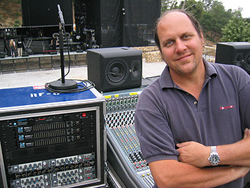
Tracks 10 & 11: A stereo keyboard sub mix, with the various keyboards play all bused here through two groups. The keys were taken via an assortment of rack mounted Radial and Whirlwind DIs. These returned to the console through two of the key inputs with EQ and inserts bypassed.
Track 12: The horn subgroup, with the trumpet input (A-T ATM25 mic through a Drawmer 241) and the trombone input (Sennheiser 421 through a Drawmer 241) combined to one track. This returned through one of the horn inputs with EQ and insert bypassed.
Track 13: A sub mix of a series of sequenced loops containing various percussion and synth sounds featured in several songs. Their source was a Pro Tools rig in the keyboard rack. I returned this into one of the loop inputs for soundchecking with EQ bypassed.
Track 14: Gwen Stefani’s lead vocal input, which used an A-T AE6100 capsule on an A-T wireless system. The capsule has a hypercardioid pattern, which is fairly important with the amount of noise on stage and the fact that she never stays still on stage. Gwen is always moving and has spent a good amount of time in front of the PA on both of the previous tours.
The A-T wireless, when set up properly, is just about the closest thing to actually having a wire on the mic, simply sounding great, and very durable. This input was sent out pre-fader and pre-EQ to the 2882.
It returned in the line input of her module so that I could check the compression (another Distressor, set at 4:1 ratio) and various reverb and delay sends. These included a short slap delay courtesy of the Kurzweil KSP8 and a beautiful room reverb from the same unit. There was also a t.c.electronic D2 delay for the longer delay stuff.
Tracks 15 & 16: Backing vocals on Shure SM58s sent pre-EQ and pre-fader, again. Returned via their respective line inputs, then through a Drawmer 241 for light compression.
There were several advantages to this approach.
Once the PA was flown and powered at a show, even if we were waiting for backline/lighting/set to be finished, I could still take a quick look at the system using SpectraFoo, and then play back the previous show to get very good idea of what was going on in the venue.
Even with just a short time window, this provided a great head start. The only difference from day to day was the actual leakage into the mics, which varied a bit from venue to venue given the proximity of the PA and room acoustics.
I also don’t use headphones, but rather, post a pair of JBL LSR6328P nearfield monitors on my console meter bridge to listen to anything both during the show or soundcheck to fine-tune something.
This, of course, was easy because I was listening to the actual material! I’ve used the JBL monitors exclusively for a few years now and believe that they’re some of the most accurate nearfield monitors available. I just run the signal through a stereo delay to line up the signal from the monitors to that of the PA.
The only thing added to my normal set-up was some extra cabling and two rack spaces worth of gear. (The third spare unit was never turned on.)
In the future, I’ll probably add more 2882s so that I can take each individual input, which would give me an even greater level of control. I’ll also probably try to convince whatever band I’m working with at the time to record every soundcheck and show.
With the prices of hard drives continuing to fall, and the advantage of being able to import files seamlessly into Pro Tools (or any program that will open Sound Designer 2 files) for further over dubbing/mixing/whatever, it only makes sense.
The quality of the audio is great, not only from a potential live record, but also from the songwriting point of view. It’s now so easy to record song ideas, and then work on them later on the bus, in a hotel room or at home.
Wherever the inspiration strikes, there you go.
